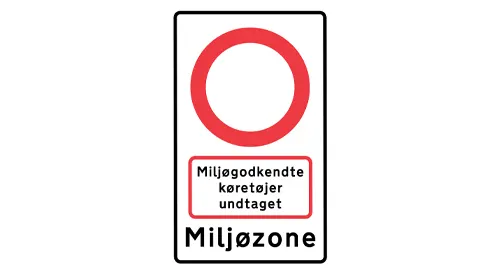- Ready to go
- Low emissions Zones in Denmark
Low emissions Zones in Denmark
Denmark's five largest cities have requirements for diesel-powered passenger cars in the low emissions zones. The requirements apply to both domestic and foreign vehicles.
The Øresund Bridge and the connecting Øresund motorway (E20) are not covered by the rules, however the area around Ørestad - including Fields and Royal Arena - are covered by the new rules as of March 1st, 2025
With this article, Øresundsbro Konsortiet wants to inform our customers about the new rules, but is not involved in Denmark's rules for environmental zones. For questions about the rules and possible fines, we therefore refer to miljoezoner.dk.

Several European countries, Denmark included, has had low emission zones for several years. The aim with these zones is to reduce air pollution, particularly in at risk areas like city centers in major cities.
Since October 1st, 2023, the rules for the low emission zones in Denmark's five largest cities, namely Copenhagen/Frederiksberg, Odense, Aarhus, and Aalborg, are stricter and on March 1, 2025, some areas were expanded.
Fines in Danish low emission zones
Low emission zones are nothing new to the Danish population; since July 1, 2020, freight transport, trucks, and buses have been subject to these regulations. Just over three years later, municipalities revised the regulations to also include passenger cars.
The enhanced tightening of rules in the low emission zones means that all diesel-powered passenger cars must have a particulate filter or be at least Euroclass 5 compliant to be used within the specified areas.
If you are unsure whether your vehicle meets the requirements, you can visit miljozoner.dk and check the status of your car. Those who violate the rules of environmental zones will be fined; currently, fines can go up to 1,500 Danish kroner for passenger cars and 12,500 Danish kroner for heavy vehicles.
However, in some cases, exceptions to the regulations may apply. For the latest updates, please visit the link here.
Map of low emission zones in Denmark
The purpose of the low emission zones is to improve air quality in urban areas to reduce the risk of residents suffering from diseases caused by environmentally harmful emissions. In Denmark, besides Copenhagen/Frederiksberg, Aarhus, Aalborg, and Odense are also included in the low emission zones. Here, you can view detailed maps of the Danish low emission zones.
When you enter a low emission zone in Denmark, you will encounter a sign with a white background, a black border, and a red circle. The Danish word "Miljøzone" is also clearly marked in black letters at the bottom of the sign.

Environmental Zones Have Automatic License Plate Recognition
Previously, approved vehicles had to display an environmental zone sticker, but now vehicles are checked through automatic license plate recognition. Even if you are driving a foreign vehicle, you will be subject to this recognition, as Danish authorities have access to various foreign vehicle registers. However, if your vehicle was registered before October 1, 2009, it needs to be registered before entering the low emission zone. When registering your vehicle, remember to include documentation confirming the installation of a particulate filter.

Rules for different vehicle types
Passenger Cars: Diesel-powered passenger cars must have a particulate filter.
Freight Transport: Older diesel-powered freight transport vehicles must have a particulate filter. This applies to both privately used and company-owned freight transport.
Trucks and Buses: Older diesel-powered trucks and buses must have a particulate filter.
Last Updated: February 27th, 2025